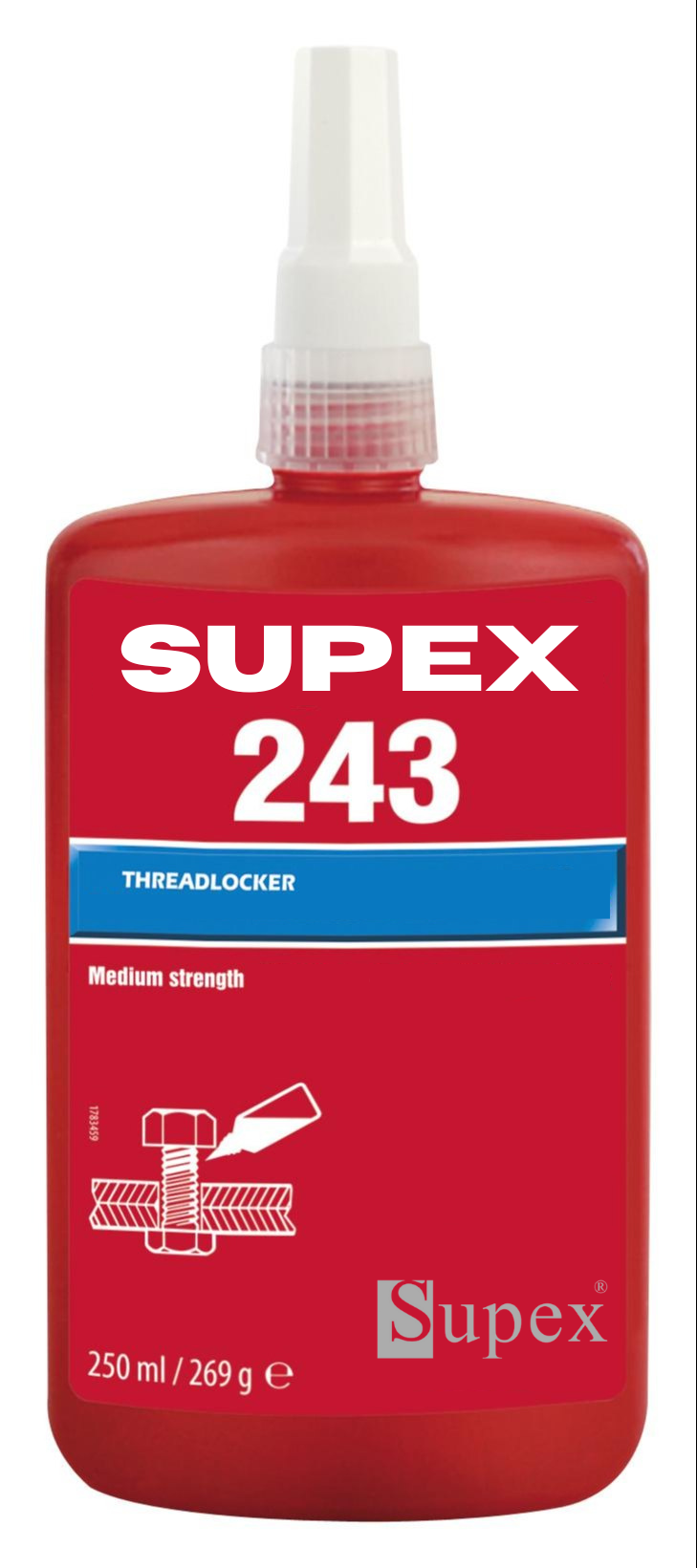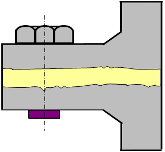Threadlockers are adhesives designed to secure threaded fasteners and prevent them from loosening due to vibration, shock, or thermal expansion. They are commonly used in mechanical assemblies, automotive applications, and industrial equipment. Threadlockers are applied to the threads of screws, bolts, or studs before assembly. Once cured, they create a strong bond that resists loosening while also sealing the threads to protect against corrosion.



Types of Threadlockers
Threadlockers come in different strengths and formulations, depending on the application:
Low Strength (Removable):
- Ideal for small screws and fasteners that may need to be adjusted or removed frequently.
- Example applications: Eyeglasses, small electronic devices.
- Example product: Supex 222.
Medium Strength (Serviceable):
- Designed for fasteners that require occasional removal with standard hand tools.
- Example applications: Automotive parts, machinery.
- Example product: Supex 242 or 243.
High Strength (Permanent):
- Provides the strongest bond and is intended for applications where disassembly is not anticipated or requires heat and special tools.
- Example applications: Heavy machinery, engines.
- Example product: Supex 270 or 272.
Wicking Grade:
- Low-viscosity adhesive that “wicks” into preassembled fasteners to secure and seal them.
- Example applications: Electrical connections, set screws.
- Example product: Supex 290.
Properties of Threadlockers
- Anaerobic Cure: Threadlockers cure in the absence of air and in the presence of metal ions, making them ideal for threaded metal fasteners.
- Temperature Resistance: Many formulations are designed to withstand extreme temperatures, ranging from sub-zero to over 500°F (260°C) for high-performance grades.
- Chemical Resistance: Most threadlockers resist chemicals like oil, fuel, and solvents.
- Sealant Properties: In addition to locking, they seal threads to prevent leaks or corrosion.
Application Tips
- Preparation: Clean threads thoroughly to remove grease, oil, or debris for optimal bonding.
- Application: Apply a small amount to the fastener threads. For through holes, apply threadlocker on the bolt; for blind holes, apply it inside the hole.
- Assembly: Assemble the parts while the threadlocker is still wet.
- Curing Time: Allow sufficient time for curing. Most threadlockers set in 10–20 minutes but may require 24 hours for full cure.
Why threadlockers ?
You tighten your fasteners, expecting them to stay secure, but over time they loosen due to constant vibration, temperature changes, or daily wear and tear. This leads to inefficiencies, unstable machinery, and even dangerous situations.
Every time a fastener works its way loose, you’re risking more than just a minor inconvenience. Loose bolts can lead to expensive repairs, unexpected downtime, and equipment failure at critical moments. Worse, in high-stakes environments like automotive or industrial settings, a single loose fastener can compromise safety, resulting in accidents or injuries. The frustration of repeatedly checking, tightening, or replacing fasteners wastes valuable time and money.
Threadlockers are the ultimate solution. By applying a small amount to your fasteners, you create a bond that resists vibration, temperature shifts, and shocks. Whether you need a removable solution for maintenance or a permanent fix for critical components, threadlockers ensure fasteners stay secure, eliminating downtime, reducing costs, and protecting against accidents. With threadlockers, you can lock it, seal it, and forget it—letting your equipment perform reliably, day in and day out.
Benefits
1. Prevent Loosening of Fasteners
- Vibration Resistance: Threadlockers secure fasteners in place, preventing them from loosening due to vibrations or dynamic loads. This is particularly valuable in machinery, vehicles, and equipment that experience constant motion.
- Shock Resistance: They protect fasteners against shock forces that could cause them to back out.
2. Prevent Leaks and Corrosion
- Sealing Properties: Threadlockers seal the threads, preventing the ingress of moisture, fluids, or gases. This makes them effective at reducing rust and corrosion.
- Fluid Resistance: They are resistant to common chemicals such as oils, fuels, and solvents, ensuring long-term durability in harsh environments.
3. Improved Reliability
- Consistent Clamp Load: By locking fasteners in place, threadlockers maintain consistent torque and clamp load, preventing joint failure over time.
- Thermal Cycling Stability: They help compensate for expansion and contraction of materials caused by temperature changes, ensuring that fasteners stay secure.
4. Ease of Application
- Simple to Use: Threadlockers are easy to apply with minimal training or tools required. They can be used on fasteners of varying sizes, materials, and configurations.
- Wicking Option: Special formulations can be applied to already-assembled fasteners, saving time during maintenance or retrofitting.
5. Versatility
- Available in different strengths (low, medium, high) to suit various applications, from small electronics to heavy machinery.
- Can be used on a wide range of materials, including metal, stainless steel, and even coated threads (with appropriate primers).
6. Cost Savings
- Reduced Maintenance: By preventing loosening, threadlockers decrease the need for frequent re-tightening or inspections.
- Lower Downtime: Equipment stays operational longer, reducing downtime caused by fastener failure or rework.
- Fewer Replacement Parts: Protecting fasteners from loosening and corrosion extends their lifespan.
7. Environmental Resistance
- Most threadlockers perform well in extreme environments, including high or low temperatures and exposure to water or harsh chemicals.
8. Increased Safety
- Secure fasteners reduce the risk of accidents caused by loose or detached components in critical assemblies, such as brakes, engines, or structural joints.
How to apply Supex threadlockers
APPLICATION TEMPERATURE:+5 ℃ to +45 ℃
1. For best results, the surface of the material to be bonded should be clean and free of grease.
2. To ensure fast and reliable curing, one bonding surface is coated with activator and the other surface is coated with glue. The parts
should be assembled immediately within 15 minutes.
3. It is recommended that the gap between the adhesive layer is 0.1mm. When the gap of the glue layer is too large (≤0.5mm) or fast
curing is required, an accelerator can be used. The components must be assembled quickly within one minute.
4. Excess threadlocker adhesive can be removed with organic solvents.
5. The bonded parts should be fixed until the adhesive is initially set.
6. After the adhesive has reached full strength, it can bear the load (full curing time is between 24 and 72 hours).
STORAGE AND SHELF LIFE
12 months in unopened packages in a cool and dry storage place at temperatures between +5 oC and 27 C, humidity between 30% and 70%. Optimal storage is at the lower half of this temperature and humidity range. To prevent contamination of unused threadlockers, do not return any material to its original container
PACKING
50mL, 250mL, 1000mL. Different packages are available
Colour: Amber
SAFETY
Keep out of reach of children. Before operation, please carefully read the specifications of products and material, and instructions on the package of container. For more information
about safety, please refer to the MSDS
Lock it in place—try threadlockers today! 🔩💪
Call / Whatsapp: +91 9699892782, Email: sales@supex.in
Click Here